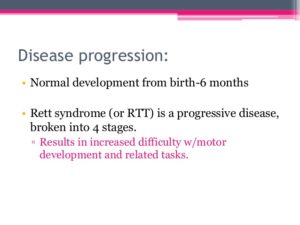Archive | June 2020
Part I Rett Syndrome Awareness Month
Rett syndrome is a rare non-inherited genetic postnatal neurological disorder that occurs almost exclusively in girls and leads to severe impairments, affecting nearly every aspect of the child’s life: their ability to speak, walk, eat, and even breathe easily. The hallmark of Rett syndrome is near constant repetitive hand movements while awake. Cognitive assessment in children with Rett syndrome is complicated, but we know that they understand far more than they can communicate to us, evidenced by their bright and attentive eyes, and their ability to express a wide spectrum of moods and emotions.
In 1954, Dr. Andreas Rett, a pediatrician in Vienna, Austria, first noticed two girls as they sat in his waiting room making the same repetitive hand-washing motions. Brett syndrome is a unique postnatal neurological disorder that is first recognized in infancy and seen almost always in girls, but can be rarely seen in boys.
This neurological disorder is where there is a mutation in a single gene, the MECP2 gene.
The MECP2 gene provides instructions for making a protein called MeCP2. This protein helps regulate gene activity (expression) by modifying chromatin, the complex of DNA and protein that packages DNA into chromosomes. The function of DNA is the blueprint of biological guidelines that a living organism must follow to exist and remain functional. Medium of long-term, stable storage and transmission of genetic information.The MeCP2 protein is present in cells throughout the body, although it is particularly abundant in brain cells.
In the brain, the MeCP2 protein is important for the function of several types of cells, including nerve cells (neurons). The protein likely plays a role in maintaining connections (synapses) between neurons, where cell-to-cell communication occurs.
Many of the genes that are known to be regulated by the MeCP2 protein play a role in normal brain function, particularly the maintenance of synapses BUT the MeCP has a permanent alteration in it so if effects the DNA and there won’t be normal function.
Affecting only children because this happens during fetal development when are DNA/RNA and genes are made up. This won’t happen in adulthood, your RNA, DNA and genes won’t change at that age.
It mostly affects girls rather than boys because the affected gene is located within the X chromosome. Chromosomes contain the set of instructions to create an organism. Men have one X chromosome and one Y chromosome, the latter being responsible for the characteristics that make men male, including the male sexual organs and the ability to produce sperm. In contrast, women have two copies of the X chromosome= XX. But, because the X chromosome carries a bigger instruction manual than the Y chromosome, biology’s solution is to largely inactivate one X chromosome in females, giving one functional copy of the X in both men and women.
Rett Syndrome is genetically based and is a very rare condition, but there is no known cure. This is a life-long condition. You can’t repair mutated genes or someone’s DNA/RNA.
Symptoms can be managed, and early detection is the key to making it easier on both the child affected and their families, but the patient will need constant care for the rest of their lives.
Often akin to the symptoms of severe autism, it is important to differentiate between the two diseases to get a correct diagnosis.
QUOTE FOR MONDAY:
“Helen’s ability to empathize with the individual citizen in need as well as her ability to work with world leaders to shape global policy on vision loss made her a supremely effective ambassador for disabled persons worldwide. Her active participation in this area began as early as 1915, when the Permanent Blind War Relief Fund, later called the American Braille Press, was founded. She was a member of its first board of directors.”
American Foundation for the Blind – AFB
QUOTE FOR THE WEEKEND:
“At the age of 19 months, Helen became deaf and blind as a result of an unknown illness, perhaps rubella or scarlet fever. With the help of Anne Sullivan (her teacher) she made Helen learn to read & talk. She made the signals have meaning in Helen’s mind. Helen made it to a BSN, just as much her’s as Anne Sullivan’s. Helen’s ideals found their purest, most lasting expression in her work for the American Foundation for the Blind (AFB). Helen joined AFB in 1924 and worked for the organization for over 40 years. The foundation provided her with a global platform to advocate for the needs of people with vision loss and she wasted no opportunity. She met with world leaders such as Winston Churchill, Jawaharlal Nehru, and Golda Meir. In 1948, she was sent to Japan as America’s first Goodwill Ambassador by General Douglas MacArthur. Her visit was a huge success; up to two million Japanese came out to see her and her appearance drew considerable attention to the plight of Japan’s blind and disabled population. Wherever she traveled, she brought encouragement to millions of blind people, and many of the efforts to improve conditions for those with vision loss outside the United States can be traced directly to her visits.”
American Foundation for the Blind – AFB
QUOTE FOR FRIDAY:
“When significant memory loss occurs among older people, it is generally not due to aging but to organic disorders, brain injury, or neurological illness. Studies have shown that you can help prevent cognitive decline and reduce the risk of dementia with some basic good health habits: staying physically active, getting enough sleep, no smoking, having good social connections, limiting alcohol to no more than one drink a day, eating a Mediterranean style diet.”
Harvard Health Publishing/Harvard Medical School
HOW TO KEEP YOUR MEMORY SHARP WITH AGE.
There’s no denying that as we age chronologically, our body ages right along with us. But research is showing that you can increase your chances of maintaining a healthy brain well into your old age if you add these “smart” foods to your daily eating regimen.
Blueberries.
“Brainberries” is what Steven Pratt, MD, author of Superfoods Rx: Fourteen Foods Proven to Change Your Life, calls these tasty fruits. Pratt, who is also on staff at Scripps Memorial Hospital in La Jolla, Calif., says that in animal studies researchers have found that blueberries help protect the brain from oxidative stress and may reduce the effects of age-related conditions such as
Alzheimer‘s disease or dementia. Studies have also shown that diets rich in blueberries significantly improved both the learning capacity and motor skills of aging rats, making them mentally equivalent to much younger rats. Ann Kulze, MD, author of Dr. Ann’s 10-Step Diet: A Simple Plan for Permanent Weight Loss & Lifelong Vitality, recommends adding at least 1 cup of blueberries a day in any form — fresh, frozen, or freeze-dried.
Wild salmon.
Deep-water fish, such as salmon, are rich in omega-3 essential fatty acids, which are essential for brain function, says Kulze. Both she and Pratt recommend wild salmon for its “cleanliness” and the fact that it is in plentiful supply. Omega-3s also contain anti-inflammatory substances. Other oily fish that provide the benefits of omega-3s are sardines and herring, says Kulze; she recommends a 4-ounce serving, two to three times a week.
Nuts and seeds.
Nuts and seeds are good sources of vitamin E, says Pratt, explaining that higher levels of vitamin E correspond with less cognitive decline as you get older. Add an ounce a day of walnuts, hazelnuts, Brazil nuts, filberts, almonds, cashews, peanuts, sunflower seeds, sesame seeds, flax seed, and unhydrogenated nut butters such as peanut butter, almond butter, and tahini. Raw or roasted doesn’t matter, although if you’re on a sodium-restricted diet, buy unsalted nuts.
Avocados.
Avocados are almost as good as blueberries in promoting brain health, says Pratt. “I don’t think the avocado gets its due,” agrees Kulze. True, the avocado is a fatty fruit, but, says Kulze, it’s a monounsaturated fat, which contributes to healthy blood flow. “And healthy blood flow means a healthy brain,” she says. Avocados also lower blood pressure, says Pratt, and as hypertension is a risk factor for the decline in cognitive abilities, a lower blood pressure should promote brain health. Avocados are high in calories, however, so Kulze suggests adding just 1/4 to 1/2 of an avocado to one daily meal as a side dish.
Whole grains.
Whole grains, such as oatmeal, whole-grain breads, and brown rice can reduce the risk for heart disease. “Every organ in the body is dependent on blood flow,” says Pratt. “If you promote cardiovascular health, you’re promoting good flow to the organ system, which includes the brain.” While wheat germ is not technically a whole grain, it also goes on Kulze’s “superfoods” list because in addition to fiber, it has vitamin E and some omega-3s. Kulze suggests 1/2 cup of whole-grain cereal, 1 slice of bread two-thee times day, or 2 tablespoons of wheat germ a day.
Beans.
Beans are “under-recognized” and “economical,” says Kulze. They also stabilize glucose (blood sugar) levels. The brain is dependent on glucose for fuel, Kulze explains, and since it can’t store the glucose, it relies on a steady stream of energy — which beans can provide. Any beans will do, says Kulze, but she is especially partial to lentils and black beans and recommends 1/2 cup every day.
Pomegranate juice.
Pomegranate juice (you can eat the fruit itself but with its many tiny seeds, it’s not nearly as convenient) offers potent antioxidant benefits, says Kulze, which protect the brain from the damage of free radicals. “Probably no part of the body is more sensitive to the damage from free radicals as the brain,” says board-certified neurologist David Perlmutter, MD, author of The Better Brain Book. Citrus fruits and colorful vegetables are also high on Perlmutter’s list of “brainy” foods because of their antioxidant properties — “the more colorful the better,” he says. Because pomegranate juice has added sugar (to counteract its natural tartness), you don’t want to go overboard, says Kulze; she recommends approximately 2 ounces a day, diluted with spring water or seltzer.
Freshly brewed tea.
Two to three cups a day of freshly brewed tea — hot or iced — contains a modest amount of caffeine which, when used “judiciously,” says Kulze — can boost brain power by enhancing memory, focus, and mood. Tea also has potent antioxidants, especially the class known as catechines, which promotes healthy blood flow. Bottled or powdered teas don’t do the trick, however, says Kulze. “It has to be freshly brewed.” Tea bags do count, however.
Dark chocolate.
Let’s end with the good stuff and my favorite desert. Dark chocolate has powerful antioxidant properties, contains several natural stimulants, including caffeine, which enhance focus and concentration, and stimulates the production of endorphins, which helps improve mood. One-half ounce to 1 ounce a day will provide all the benefits you need, says Kulze. This is one “superfood” where more is not better. “You have to do this one in moderation,” says Kulze.
Lastly the prevention of diseases that can impact all organs including our brain. With obesity comes the risk of heart disease, diabetes II, that can lead into further problems down the road with other systems of the human body. To get on prevention check if your body mass index is in the range it should be and if your not sure check online BMI where it is for free.
QUOTE FOR THURSDAY:
“Eat all the foods you enjoy—but the key is to do it in smaller quantities, says Elisa Zied, RDN, who has lost and kept off more than 30 pounds since her highest weight in high school. Greens, oranges, reds, purples, yellows…you get the picture. Eating the rainbow will supply your body with a range of disease-fighting phytonutrients, and will naturally fill you up to help you cut back on unhealthy foods, says Dr. Lipman. Remember simple exercises 10minutes a day can boost the metabolism and walking 2 miles a day will help with breakdown.”
Health.com
QUOTE FOR WEDNESDAY:
“Stress is how the brain and body respond to any demand. Any type of challenge—such as performance at work or school, a significant life change, or a traumatic event—can be stressful. Everyone experiences stress from time to time. There are different types of stress—all of which carry physical and mental health risks. A stressor may be a one-time or short-term occurrence, or it can happen repeatedly over a long time. Some people may cope with stress more effectively and recover from stressful events more quickly than others.”
NIMH National Institute of Mental Health
QUOTE FOR TUESDAY:
“Smoking can cause lung disease by damaging your airways and the small air sacs (alveoli) found in your lungs. Lung diseases caused by smoking include COPD, which includes emphysema and chronic bronchitis. Cigarette smoking causes most cases of lung cancer.”
CDC
Do you smoke? If yes, well why don’t you just drink poison?
Let’s start with what smoking actually does to the body. Smoking harms nearly every organ of the body. Smoking causes many diseases and reduces the health of smokers in general. It primarily starts at the lungs. How? Well think of your lung tissue with openings all over which are air sacs called alveoli. This is an anatomical structure that has the form of a hollow cavity which does the exchange of oxygen and carbon dioxide in and out of our body, when we inhale and exhale. The thing to know about this tissue is that before you start smoking the alveoli are expandable (think of it like a rubber band) allowing the person to get a good exchange of oxygen getting in the body to go to all our tissues and carbon dioxide getting out of the body (O2=oxygen being the fuel to our tissues and without it causes cellular starvation, carbon dioxide=CO2 being an acid / toxin to the human body and exhaled by the lungs). After years of smoking the alveoli stretches out not allowing a good exchange of O2 and CO2. The sad thing for a smoker is the alveoli cannot REVERSE back after damage has already occurred unless you had a lung transplant with continuing to smoke, which no M.D. or health insurance would allow. More realistic would be QUIT the bad habit. The tissue doesn’t get completely better but it improves when you quit. So the pt with Emphysema has alveoli that can’t exchange oxygen and carbon dioxide from the blood like it use to at the bottom of the lungs, prior to even starting to smoke. Also, after smoking years and when diagnosed with COPD you have difficulty breathing (that is why smoking is a major cause of bronchitis or Emphysema=types of chronic obstructive pulmonary disease=COPD and it is not REVERSIBLE). Emphysema is the worst type of COPD you can get. COPD is the third leading cause of death in the U.S., and the economic burden of COPD in the U.S. in 2007 was $42.6 billion in health care costs and lost productivity. Isn’t this reason enough to stop smoking?
Emphysema is an enlargement of the air spaces distal to the terminal bronchioles, with destruction of their walls. People with emphysema have historically been known as “Pink Puffers”, due to their pink complexion.
Chronic bronchitis is defined in clinical terms as a cough with sputum production on most days for 3 months of a year, for 2 consecutive years. People with advanced COPD that have primarily chronic bronchitis were commonly referred to as “Blue Bloaters” because of the bluish color of the skin and lips (cyanosis) along with hypoxia and fluid retention.
Know when the lungs get effected in time the heart gets effected. One Affects the other in time. The heart can’t live without the lungs and vice versa.
Now knowing just this you’ll understand why smoking alone can cause the following conditions, Through the Centers for Disease Control and Prevention. They state the following:
Smoking and Increased Health Risks
Compared with nonsmokers, smoking is estimated to increase the risk of—
- Coronary heart disease by 2 to 4 times, (causing atherosclerosis=thickening of the vessels or due to arteriosclerosis=hardening of the arteries and remember smoking causes vasoconstriction of the vessels = increase pressure in the vessels = high B/P.
- Stroke by 2 to 4 times(Due to causingthe above problems listed under coronary heart disease.)
- Men developing lung cancer by 23 times,
- Women developing lung cancer by 13 times(cancers due to constant irritation of the tissues) , and
- Dying from chronic obstructive lung diseases (such as chronic bronchitis and emphysema) by 12 to 13 times. ( Explained at the top)
Smoking and Cardiovascular Disease
- Smoking causes coronary heart disease, the leading cause of death in the United States.
- Cigarette smoking causes reduced circulation by narrowing the blood vessels (arteries) and puts smokers at risk of developing peripheral vascular disease (i.e., obstruction of the large arteries in the arms and legs that can cause a range of problems from pain to tissue loss or gangrene) This pain to gangrene to amputation is due to lack of oxygenated blood getting to the tissue caused by the vasoconstriction the cigarette smoking caused.
- Smoking causes abdominal aortic aneurysm (i.e., a swelling or weakening of the main artery of the body—the aorta—where it runs through the abdomen). An aneurysm with constant vasoconstriction (increases pressure) puts the aneurysm at risk for rupture because the aneurysm area isn’t as strong as the other vessels=Rupture of the aortic aneurysm
Smoking and Respiratory Disease
- Smoking causes lung cancer.
- Smoking causes lung diseases (e.g., emphysema, bronchitis, chronic airway obstruction) by damaging the airways and alveoli (i.e., small air sacs) of the lungs.
Smoking and Cancer
Smoking causes the following cancers: (in alphabetical order)
- Acute myeloid leukemia
- Bladder cancer
- Cancer of the cervix
- Cancer of the esophagus
- Kidney cancer
- Cancer of the larynx (voice box)
- Lung cancer
- Cancer of the oral cavity (mouth)
- Pancreatic cancer
- Cancer of the pharynx (throat)
- Stomach cancer
Smoking and Other Health Effects
Smoking has many adverse reproductive and early childhood effects, including increased risk for—
- Infertility
- Preterm delivery
- Stillbirth
- Low birth weight
- Sudden infant death syndrome (SIDS).1,2,9
Smoking is associated with the following adverse health effects:1
- Postmenopausal women who smoke have lower bone density than women who never smoked.
- Women who smoke have an increased risk for hip fracture than women who never smoked.
References
- U.S. Department of Health and Human Services. The Health Consequences of Smoking: A Report of the Surgeon General. Atlanta: U.S. Department of Health and Human Services, Centers for Disease Control and Prevention, National Center for Chronic Disease Prevention and Health Promotion, Office on Smoking and Health, 2004 [accessed 2013 June 28].
- U.S. Department of Health and Human Services. How Tobacco Smoke Causes Disease: What It Means to You. Atlanta: U.S. Department of Health and Human Services, Centers for Disease Control and Prevention, National Center for Chronic Disease Prevention and Health Promotion, Office on Smoking and Health, 2010 [accessed 2013 June 28].
- Centers for Disease Control and Prevention. Annual Smoking-Attributable Mortality, Years of Potential Life Lost, and Productivity Losses—United States, 2000–2004. Morbidity and Mortality Weekly Report 2008;57(45):1226–8 [accessed 2013 June 28].
- Centers for Disease Control and Prevention. QuickStats: Number of Deaths from 10 Leading Causes–National Vital Statistics System, United States, 2010. Morbidity and Mortality Weekly Report 2013:62(08);155. [accessed 2013 June 28].
- Mokdad AH, Marks JS, Stroup DF, Gerberding JL. Actual Causes of Death in the United States. JAMA: Journal of the American Medical Association 2004;291(10):1238–45 [cited 2013 June 28].
- U.S. Department of Health and Human Services. Reducing the Health Consequences of Smoking: 25 Years of Progress. A Report of the Surgeon General. Rockville (MD): U.S. Department of Health and Human Services, Public Health Service, Centers for Disease Control, National Center for Chronic Disease Prevention and Health Promotion, Office on Smoking and Health, 1989 [accessed 2013 June 28].
- Ockene IS, Miller NH. Cigarette Smoking, Cardiovascular Disease, and Stroke: A Statement for Healthcare Professionals from the American Heart Association. Circulation 1997;96(9):3243–7 [accessed 2013 June 28].
- Institute of Medicine. Secondhand Smoke Exposure and Cardiovascular Effects: Making Sense of the Evidence. [PDF–707 KB] Washington: National Academy of Sciences, Institute of Medicine, 2009 [accessed 2013 June 28].
- U.S. Department of Health and Human Services. Women and Smoking: A Report of the Surgeon General. Rockville (MD): U.S. Department of Health and Human Services, Public Health Service, Office of the Surgeon General, 2001 [accessed 2013 June 28].
GET IT NOw? Please say yes. Smoking rots for your body not just in the lungs but everywhere. How do you make a complete turn-around? Look at your health in regards to what your goal is out of life. Do you want to live longer and most importantly HEALTHIER? When healthier in mind and body you are able to do more with your life in activities of daily living and more than that, so QUIT. If you want to sit most of your life with continuing to smoke but if not you must stop smoking now unless you have a unusual discipline in your way of living that allows you to have a about 6 cigarettes to 1 pack a YEAR, not daily. It is recommended you stop completely but if it actually has to be a part of your life than do it in moderation or less. If you’re able to do that your definitely not addicted to the bad habit physically, if anything addicted to it mentally. That would still make your life healthier as to smoking frequently every day. Know you take the risk of increasing your quantity in time so I recommend Quit.
Various lifestyle factors have been associated with increasing the risk of stroke. These include lack of exercise, alcohol, diet, obesity, smoking, drug use, and stress. Guidelines endorsed by the Centers for Disease Control and Prevention and the National Institutes of Health recommend that Americans should exercise for at least 30 minutes of moderately intense physical activity on most, and preferably all, days of the week. Recent epidemiologic studies have shown a U-shaped curve for alcohol consumption and coronary heart disease mortality, with low-to-moderate alcohol consumption associated with lower overall mortality. High daily dietary intake of fat is associated with obesity and may act as an independent risk factor or may affect other stroke risk factors such as hypertension, diabetes, hyperlipidemia, and cardiac disease. Homocysteine is another important dietary component associated with stroke risk, while other dietary stroke risk factors are thought to be mediated through the daily intake of several vitamins and antioxidants. Smoking, especially current smoking, is a crucial and extremely modifiable independent determinant of stroke. Despite the obstacles to the modification of lifestyle factors, health professionals should be encouraged to continue to identify such factors and help improve our ability to prevent stroke, decrease cancers caused by smoking, decrease coronary artery disease, and obesity. Learn healthy habits or healthier habits, broaden your knowledge on the 4 food groups in what is lean or leaner or leanest with each group, increase your activity 30 minutes a day and learn what a healthy diet actually is through Dr. Wayne Scott Anderson’s book “Dr. A’s habits of health”.




